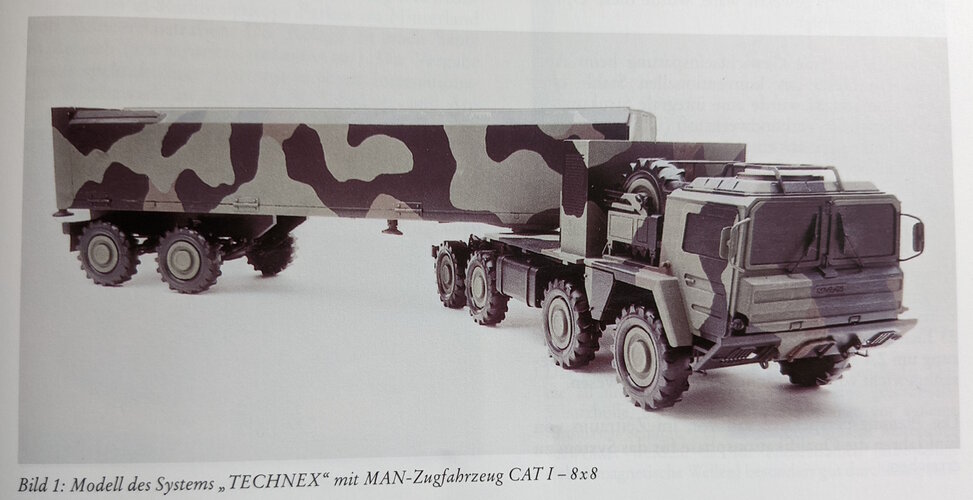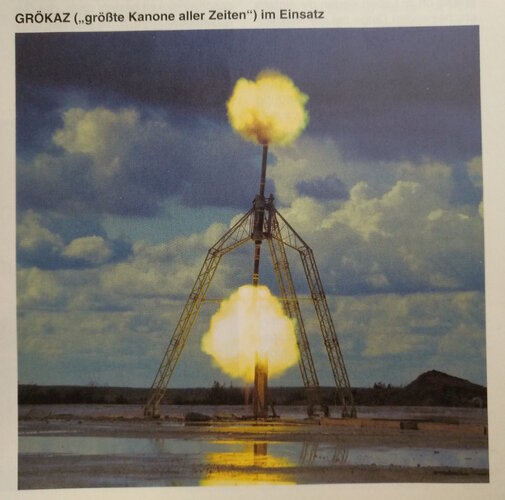Around the ears (its a german phrase, up to his ears might be a better translation, but it can also mean explode/blow up)
The Defense Ministry had to stop its missile studies; the chancellor demanded "damage limitation" from Scholz.
12.02.1989 from DER SPIEGEL 7/1989
On Ash Wednesday morning, it became too much for the chancellor. "What are you actually doing up there?" Helmut Kohl harangued his defense minister on the telephone. He expected a status report within an hour.
The chancellor's carnival mood had been spoiled by a report in the TV magazine "Report" that the Munich-based armaments company Messerschmitt-Bölkow-Blohm (MBB), together with the American "Pershing" manufacturer Martin Marietta, was developing a missile that could fly 490 kilometers and carry a nuclear warhead as well as conventional ammunition.
Punctually as ordered, Rupert Scholz arrived at the Chancellor's Office at 10:30 am. He had, he confessed, only just begun to consider the project. "Is it absolutely necessary for you to pursue this?" Kohl asked his defense minister and the only military man in the room, press spokesman Colonel Winfried Dunkel.
The colonel tried to persuade the chancellor that a missile using conventional munitions to destroy runways "makes perfect sense." In order to paralyze the enemy air force, bombardments with low-flying combat aircraft would then be largely superfluous. This would also greatly reduce low-flying training over the Federal Republic of Germany.
But Kohl did not want to get involved in such arguments. He told the audience that he was only concerned with "damage limitation". If the Germans - who were already the target of criticism from West and East because of their assistance in the construction of poisonous weapons and missiles - now also built their own short-range missile, "we'll get our ears blown off worldwide".
(I would guess this refers to Iraq)
Scholz understood; He "didn't necessarily have to have the thing. Government spokesman Friedhelm Ost was allowed to announce that Bonn would not "pursue" the "Technex" experimental program for the time being because of the "positive disarmament signals from the Warsaw Pact".
Hardthöhen spokesman Dunkel and his MBB colleague Udo Philipp, however, continued to cause confusion. It is not about a rocket at all, but only about a warhead that is supposed to tear craters in concrete runways with "daughter projectiles".
(Submunitions)
But what is the point of a warhead without a delivery system? In the advertising brochures of MBB and Martin Marietta there is also information about a missile and the carrier vehicle. Martin Marietta even depicts two missile variants with the designations T3NP and T3ND in full detail.
(I would love to see those brochures)
MBB, the U.S. company and nine other German defense firms have so far received 88 million marks from the Bonn defense ministry for their work; this year, another five million will be due. The money was spent on about 30 researchers - and on secret experiments with warheads at the German test site in Meppen and the American missile firing range at White Sands in the state of New Mexico.
The Bundestag's budget committee could have known about the project if it had asked. The expenditures, as committee chairman Rudi Walther (SPD) found out last week, were hidden under several "harmless titles" in the chapter on "Defense Technology Development and Testing."
The parliamentarians only learned more about the "missile with the Mercedes star" (SPD Member of Parliament Gernot Erler) - unofficially - in December of last year, when a representative of Martin Marietta thrust a 19-page MBB paper into the hand of MP Walther "between door and door".
(in passing)
Initial considerations for the conventional short-range missile had already been made in the early 1980s. In the 1983 Bundeswehr Plan, then Inspector General Wolfgang Altenburg called for a successor system to the 72 Pershing 1A nuclear missiles of the Bundeswehr; at that time, the idea arose of designing the Pershing successor to be dual-purpose, i.e., for nuclear and conventional warheads.
In 1985, Scholz's predecessor Manfred Wörner invented a "European Defense Initiative" as a complement to the American SDI concept; the "extended air defense" was to shoot down not only aircraft but also missiles of the enemy. Wörner then secretly had "Technex" converted into an attack system. The Federal Security Council (chaired by Helmut Kohl) gave its approval on July 24, 1985. According to a secret Hardthöhen directive dated October 7, 1985, a conventional warhead was to be designed for the Pershing successor: "Range 700 to 800 kilometers."
But nothing came of it. In 1987, the Americans and the Soviets agreed to dismantle medium-range weapons with a range of 500 to 5,000 kilometers.
In order not to deprive industry of the study funds ("up to a maximum of 100 million marks") approved by the Federal Security Council, Wörner ordered at the end of 1987 that the planned missile should not fly further than 490 kilometers; it is now known in thick papers in the defense ministry as the "Complementary Air Attack System" (Kolas).
The MBB people quickly found a justification for the new firing system. Missiles for attacks on Eastern bloc airfields were necessary because the strong air defenses would shoot down half of the Western fighter-bombers - like the MBB "Tornado" - in three days. And 250 missiles only cost a good three billion marks - in contrast to the 35 billion that German taxpayers have had to spend on some 300 Tornadoes.
These sales arguments of the "defense technology" department led to a domestic quarrel with the "aircraft" division at MBB last week: the super bird "Tornado" almost worthless? What should the members of parliament say, who had just been made to believe that the 100 billion project "Fighter 90" was necessary to guide low-flying Tornados into enemy territory and to strengthen the company's own air defenses? MBB is planning and firing everywhere.
Meanwhile, the Americans are not dwelling on studies. John Tower, the designated Secretary of Defense, informed the Senate that the "Mars" missile
(launcher), which has already been introduced in Europe by the Bundeswehr and the U.S. Army, is "currently" planned as the launcher for the "Lance" successor missile "Atacms" (range: 480 kilometers), which can be deployed both conventionally and nuclear.
This would increase the number of launchers for nuclear and conventional short-range missiles stationed in Europe almost ninefold: instead of 88 Lance launchers, there would be 750 Mars launchers.
Translated with DeepL




